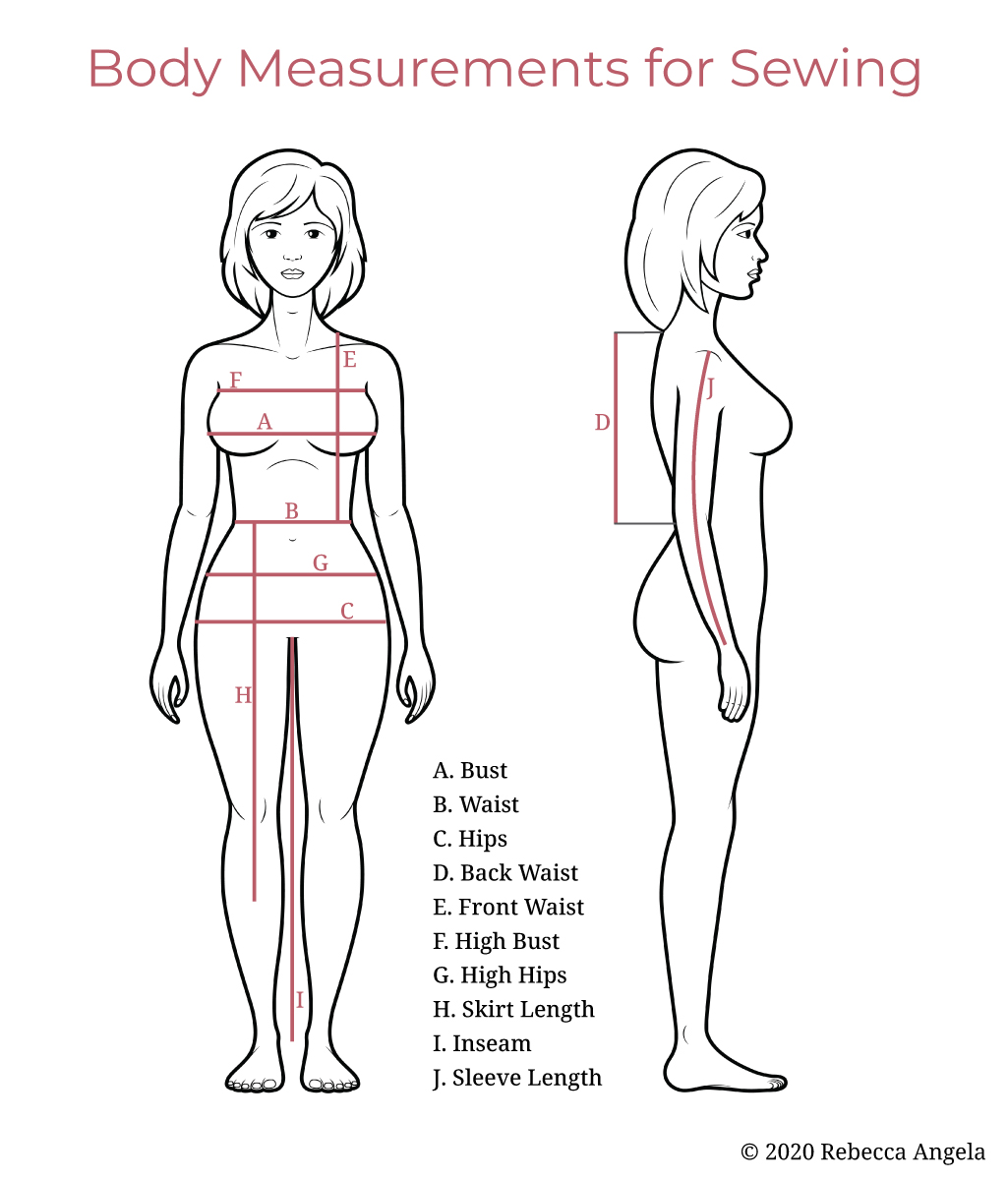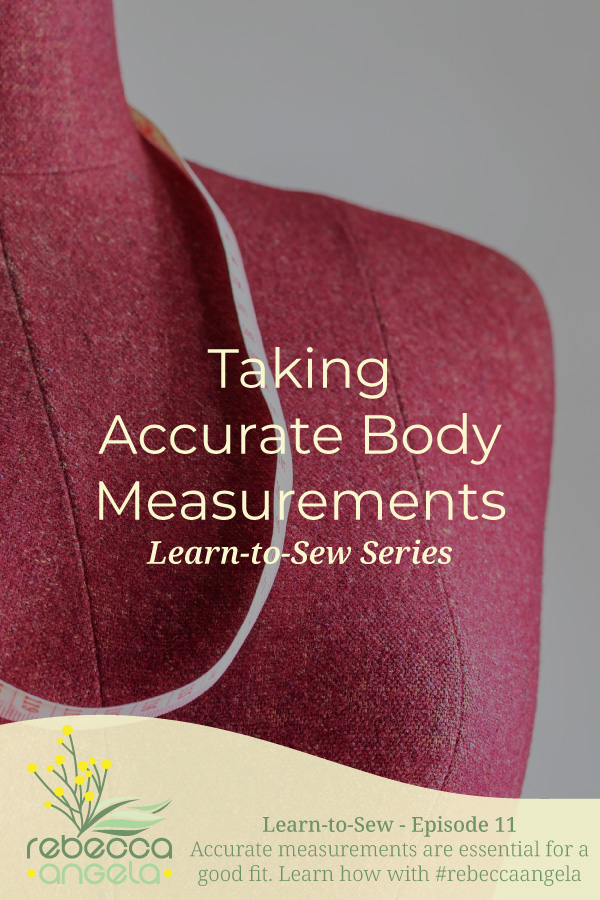Measuring your body is important
Garment sizing is confusing. There doesn’t seem to be a reliable standard – you might be a Size 12 in one store but barely manage to pull up the zipper on a Size 14 in the next. It doesn’t get much better when you make your own clothes. Pattern companies do vary in their sizing definitions and the terminology changes from country to country. So, when sewing garments, taking accurate body measurements is essential for a good fit and satisfaction with the final product. It is especially important not to assume that if you are a size 14 in off-the-rack clothes, you should cut out the size 14 from the pattern. You must work out what pattern size is closest to your actual body measurements and use the appropriate cutting lines. So how do you do it?
How to take accurate body measurements
Measuring your body is easiest with a trusted helper but, as I usually don’t have anyone around to help me when I need it, I have learnt to do it myself and so can you. Now, before we start, I just want to say, the numbers you come up with don’t matter – except for finding your correct fit. Don’t avoid taking your measurements because you are afraid of what they might say. No one else has to know and well-fitting clothes will be your reward. This is a judgement-free zone, ok?
Right, now we have settled that, gather what you will need. It won’t take long because all you need is a flexible, non-stretchy measuring tape, a piece of paper (or my free Body Measurement Worksheet), a pencil and a full length mirror. The mirror is important if you are doing your measurements for yourself. You need to be able to see that you are holding the tape in the right position.
Obviously you need to remove most of your clothing (another reason I generally do it myself!). There is no point trying to measure yourself wearing jeans and a bulky jumper. You might get away with a close-fitting t-shirt but I recommend just wearing your underwear. It is good for women to wear the bra they will most likely wear with the garment. If you often wear a padded t-shirt bra, but measure yourself in a regular bra, a very fitted garment may end up being too tight across your bust.
To provide a guide for some of the measurements, tie a piece of ribbon or elastic snugly around your waist. Wriggle around until it settles into your natural waistline.

Circumference measurements
Circumference measurements are those that measure all around your body. The tape measure is held parallel to the floor. Because we are all by our nature a bit squidgy, when taking the measurements are sure you pull the tape around yourself so that it is making good contact with your body but not pulling it in in any way. You don’t want to pull it tight enough to cut in or make an indent in your flesh. Your main circumference measurements will be your bust, waist and hips.
Bust (or chest)
Measure your bust or chest at its fullest point (A), generally across the nipples.
Waist
Measure around your waist where the ribbon or elastic has settled (B).
Hips
Measure around your hips at their fullest part, usually around the bottom (C). Some patterns state exactly where to take this measurement for example 9″ below the waist. Follow specific pattern instructions but if no guideline is given, go with your fullest part.
Length measurements
Back Waist Length
This is a tricky one to do on your own but no impossible! Measure from the nape of your neck (where the most prominent bone at the top of the back is) down the middle of your back to the ribbon or elastic you have tied around your waist (D).
Front Waist Length
Measure from the top of your shoulder where it meets your neck, over your fullest bust point, to the ribbon around your waist (E).
Less frequently used measurements
The five measurements above are the basic measurements you will need for most patterns. There are a few others that you may come across depending on the type of garment you are making.
High Bust
This measurement is taken above the bust line, under the arms (close to the armpits) generally around the broadest part of your back (F).
High Hip
The high hip measurement is taken across your belly, again around your fullest part. Somewhere between 7 and 10cm (3-4″) below your waist (G).
Skirt Length
Skirt length is a personal preference (and obviously varies depending on the style of dress or skirt you are making) so measure from the ribbon around your waist to the point where you want your hem to fall (H).
Inseam
The inseam is the seam on pants on the inside of your leg (I). This is a very tricky one to measure on yourself but if you have a pair of tight-fitting pants that fit you well, you can measure the inseam length of your pants to determine your inseam measurement. Be aware of taking into account the style of pant you are making though. If you are making a three-quarter length pant, the inseam length will be different from your ankle-length jeans.
Sleeve (Arm) Length
You must bend your arm to measure your sleeve length so that there is some give in the sleeve when it is made. So, with a bent arm, measure from the top of your arm (at the boney point) to your wrist (J).
Body Measurements Worksheet
To help you record these measurements, I have made a downloadable worksheet for you. Print it off and use it to guide you through your measurement taking.
Now compare the measurements you have taken to those on the pattern. Find the size that is closest to your measurements, stepping up to the larger size if you are between sizes. You may find that you do not fit the body shape specified by the pattern. Your bust might be a size larger than your waist and hips for example. If this is the case, you may need to adjust your pattern to fit your measurements. The extent to which this is necessary will depend on the style of garment you are making. It will be more important for a closely fitted garment. Of course, if you are making a skirt, your bust measurement is irrelevant!
Finally, I recommend checking at least your basic measurements each time you sew a new garment. I don’t know about you, but my measurements are always in a state of flux!
Happy sewing!

